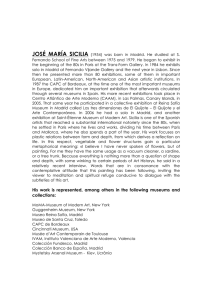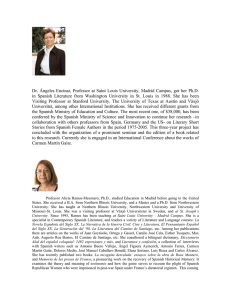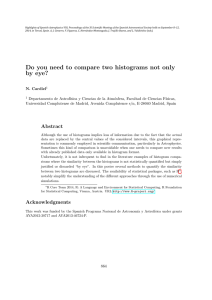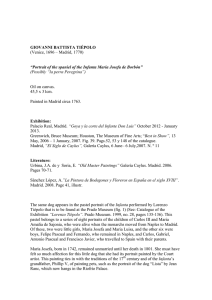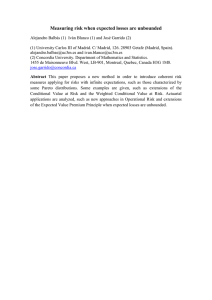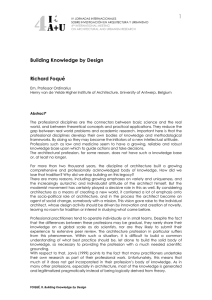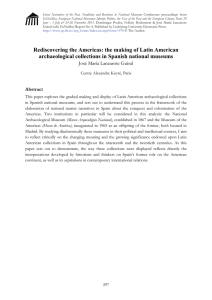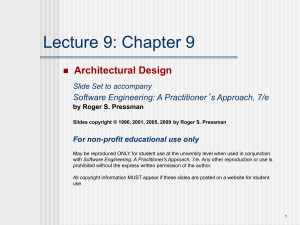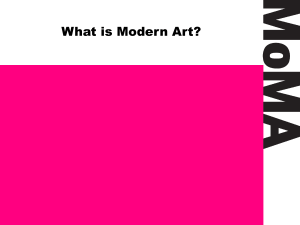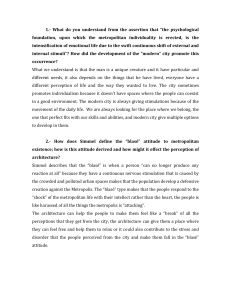Spain Builds - Arquitectura Viva
Anuncio
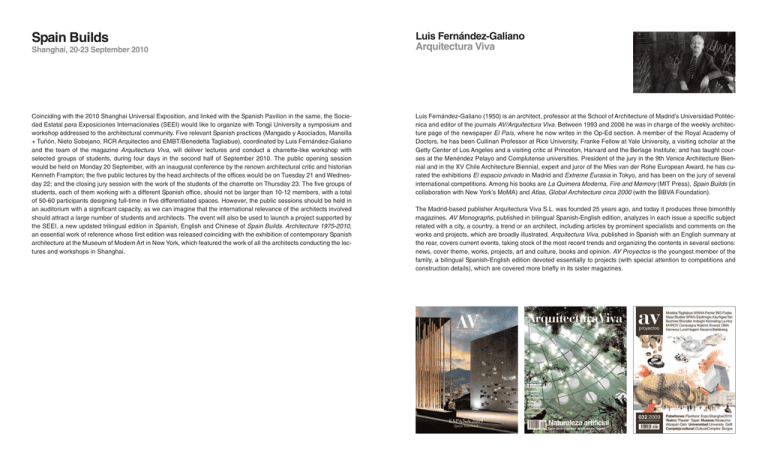
Spain Builds Shanghai, 20-23 September 2010 Coinciding with the 2010 Shanghai Universal Exposition, and linked with the Spanish Pavilion in the same, the Sociedad Estatal para Exposiciones Internacionales (SEEI) would like to organize with Tongji University a symposium and workshop addressed to the architectural community. Five relevant Spanish practices (Mangado y Asociados, Mansilla + Tuñón, Nieto Sobejano, RCR Arquitectes and EMBT/Benedetta Tagliabue), coordinated by Luis Fernández-Galiano and the team of the magazine Arquitectura Viva, will deliver lectures and conduct a charrette-like workshop with selected groups of students, during four days in the second half of September 2010. The public opening session would be held on Monday 20 September, with an inaugural conference by the renown architectural critic and historian Kenneth Frampton; the five public lectures by the head architects of the offices would be on Tuesday 21 and Wednesday 22; and the closing jury session with the work of the students of the charrette on Thursday 23. The five groups of students, each of them working with a different Spanish office, should not be larger than 10-12 members, with a total of 50-60 participants designing full-time in five differentiated spaces. However, the public sessions should be held in an auditorium with a significant capacity, as we can imagine that the international relevance of the architects involved should attract a large number of students and architects. The event will also be used to launch a project supported by the SEEI, a new updated trilingual edition in Spanish, English and Chinese of Spain Builds. Architecture 1975-2010, an essential work of reference whose first edition was released coinciding with the exhibition of contemporary Spanish architecture at the Museum of Modern Art in New York, which featured the work of all the architects conducting the lectures and workshops in Shanghai. Luis Fernández-Galiano Arquitectura Viva Luis Fernández-Galiano (1950) is an architect, professor at the School of Architecture of Madrid’s Universidad Politécnica and editor of the journals AV/Arquitectura Viva. Between 1993 and 2006 he was in charge of the weekly architecture page of the newspaper El País, where he now writes in the Op-Ed section. A member of the Royal Academy of Doctors, he has been Cullinan Professor at Rice University, Franke Fellow at Yale University, a visiting scholar at the Getty Center of Los Angeles and a visiting critic at Princeton, Harvard and the Berlage Institute; and has taught courses at the Menéndez Pelayo and Complutense universities. President of the jury in the 9th Venice Architecture Biennial and in the XV Chile Architecture Biennial, expert and juror of the Mies van der Rohe European Award, he has curated the exhibitions El espacio privado in Madrid and Extreme Eurasia in Tokyo, and has been on the jury of several international competitions. Among his books are La Quimera Moderna, Fire and Memory (MIT Press), Spain Builds (in collaboration with New York’s MoMA) and Atlas, Global Architecture circa 2000 (with the BBVA Foundation). The Madrid-based publisher Arquitectura Viva S.L. was founded 25 years ago, and today it produces three bimonthly magazines. AV Monographs, published in bilingual Spanish-English edition, analyzes in each issue a specific subject related with a city, a country, a trend or an architect, including articles by prominent specialists and comments on the works and projects, which are broadly illustrated. Arquitectura Viva, published in Spanish with an English summary at the rear, covers current events, taking stock of the most recent trends and organizing the contents in several sections: news, cover theme, works, projects, art and culture, books and opinion. AV Proyectos is the youngest member of the family, a bilingual Spanish-English edition devoted essentially to projects (with special attention to competitions and construction details), which are covered more briefly in its sister magazines. Francisco Mangado Mangado y Asociados Luis Moreno Mansilla and Emilio Tuñón Mansilla + Tuñón Born in Estella (Navarra), in 1957, Mangado studied at the School of Architecture of Navarre in Pamplona, where he is professor of Architectural Design. He became known with such works as the Plaza Carlos III and the Marco Real Winery, both in Olite. Other works include the redesign of the Mendillorri area in Pamplona, the Zuasti Golf Club, and the indoor swimming pool in La Coruña. In 1998 his project was selected for the construction of the Congress Center and Auditorium of Navarra ‘Baluarte’, which was completed in 2003 and included two years later, along with the project for the Ávila Congress Center – completed in 2009 – in the MoMA exhibition On-Site: New Architecture in Spain. His long list of works includes the Pey-Berland Square in Bordeaux and Plaza Dalí in Madrid, both of 2004; the Soccer Stadium La Balastera in Palencia, of 2006; and the Spanish Pavilion for Expo Zaragoza 2008, recently awarded with the García Mercadal Prize presented by the Architectural Association of Aragón, the National Architecture Prize granted by the Spanish Institute of Architects (CSCAE) and the Giancarlo Ius Gold Medal of the UIA. Born in Madrid in 1958 and 1959, respectively, they both studied at the Madrid School of Architecture, and, before forming a partnership, worked for ten years in the studio of Rafael Moneo. In 1993 they founded the “thought cooperative” ‘Circo’, which publishes a monthly bulletin under the same name. The Fine Arts Museum of Zamora, the Swimming Center of San Fernando de Henares, and the Auditorium in León were among the group nominated for candidates for the Mies van der Rohe Award in 1996, 1998 and 2003, a prize that went a few years later, in 2007, to their Museum of Contemporary Art of Castilla y León (MUSAC), which opened in 2004. They are the authors of the Madrid Regional Documentary Center, completed in 2002, and of the Barrié de la Maza Foundation building in Vigo, inaugurated in 2005. Their current projects in progress include the Museum of Cantabria (featured, along with the MUSAC, in the 2005 MoMA exhibition On-Site: New Architecture in Spain), the Lalín Town Hall in Pontevedra and, in their city, the Museum of Royal Collections, the Museum of Automotion and the International Congress and Convention Center. Fuensanta Nieto y Enrique Sobejano Nieto Sobejano Rafael Aranda, Carme Pigem, Ramón Vilalta RCR Arquitectes Both born in Madrid in 1957, they studied at the Madrid School of Architecture, and obtained their post-graduate degrees at New York’s Columbia University. Editors of the college magazine Architecture from 1986 to 1991, directors of architecture courses of the Complutense University from 1998 to 1992, Fuensanta Nieto currently teaches at the European University of Madrid and Enrique Sobejano at the Universität der Künste of Berlin. Winners of a Europan award in 1996, their works include the construction of a prize-winning housing project in Seville (selected for the MoMA exhibition On-Site: New Architecture in Spain), the rector’s office of Vigo University, a block of flats in Parla, Madrid, and the Latina Municipal Council building, also in Madrid. Outside our country they have carried out dwellings in Groningen, Netherlands; the extension of Moritzburg Museum, a completion of 2008, in Halle, Germany; and they are currently developing the Kastner & Öhler enlargement in Graz, Austria. The list of recently completed works in Spain includes the Madinat al-Zahra Museum in Córdoba and the Congress Center for Expo Zaragoza 2008. Ramón Vilalta was born in Vic in 1960, and his partners Rafael and Carme in Olot in 1961 and 1962, respectively. The three of them studied at the Vallés School of Architecture, where Carme was professor of Architectural Design between 1992 and 1999, and Ramón of Town Planning and Landscape Architecture from 1989 to 2001. Consultant architects for the La Garrotxa Natural Park, they have been finalists and/or nominees in 14 editions of the FAD Awards, and two of their projects —the Riudaura Cultural Center and the Tussols-Basil Athletics Track— were selected for the 2001 and 2003 editions of the Mies van der Rohe awards. Other works include a variety of houses (among them the Mirador, M-Lidia and the Horizonte houses, this last one included in the MoMA’s exhibition on Spanish architecture), the Law Faculty of Gerona, of 1999, the Restaurant Les Cols, of 2002 (extended with guest pavilions in 2005), the Els Colors Kindergarten in Manlleu, of 2004, the Library and Center for the Elderly in Barcelona and the Bell-lloc Winery in Palamós, both completed in 2007. Their professional activity also includes industrial design, with products such as the Pla Washbasin and the NET shower base. Benedetta Tagliabue EMBT Born in Milan in 1963, Benedetta Tagliabue earned her architectural degree at the University of Venice in 1989, and furthered her studies in New York prior to moving to Barcelona, where she joined the studio of Enric Miralles in 1991. Her work with the late architect includes several projects in Barcelona such as Parque Diagonal Mar, completed in 2002, Santa Caterina Market, of 2005, and the Gas Natural Headquarters, of 2006 and selected for the MoMA exhibition On-Site: New Architecture in Spain; and also works abroad like the School of Music in Hamburg, the City Hall in Utrecht, both opened in the year 2000, and the Scottish Parliament Building, completed in 2004 and awarded with the RIBA’s Stirling Prize and with the Spanish National Architecture Prize Manuel de la Dehesa. Tagliabue is a regular contributor to architectural magazines and also teaches at prestigious academic institutions in Spain and abroad. She directs a studio that develops architectural projects, open spaces, urban planning, refurbishment and exhibitions, and that is currently in charge of the construction of the Spanish Pavilion for the 2010 Shanghai World Expo.
